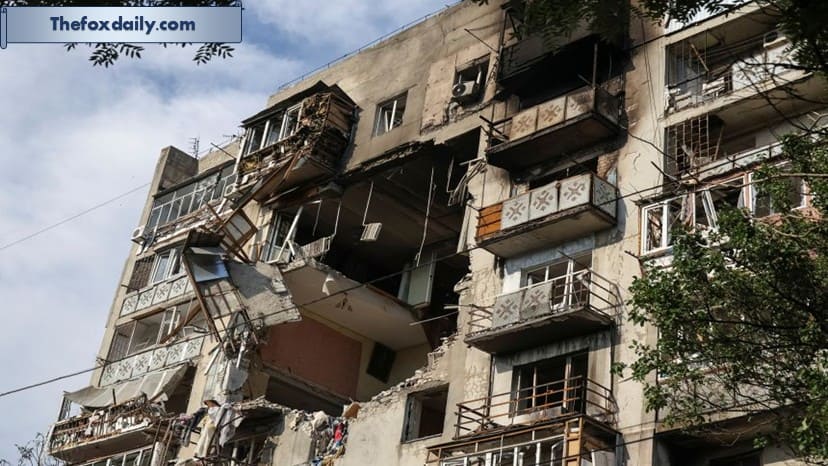
Far beyond the front line, another onslaught is underway as Russia‘s war machine churns on in eastern Ukraine. As it rapidly develops its manufacturing of deadly weapons, Russia is expanding its nightly drone attacks on Ukrainian cities and civilian infrastructure.
Although many of the drones aren’t very quick or sophisticated, experts claim that the Kremlin could fire over 700 of them in a single night at a low cost in an attempt to overwhelm Ukraine’s air defenses and destroy civilian morale.
Russia constructed its own enormous facility to produce thousands of Shahed attack drones every month after acquiring Iranian designs for these weapons. As less expensive defense strategies lose their effectiveness due to its changing tactics, Ukraine is being forced to retaliate with more costly weaponry and technologies.
Drone strikes have increased dramatically, demonstrating how warfare has changed to depend on these unmanned autonomous vehicles.
While this dynamic isn’t true for all Western powers, Ukraine and Russia have been compelled to enhance their drone capabilities in order to make up for their air force’s shortcomings. However, in order to maintain an advantage in any future confrontations, experts suggest that the US and its NATO partners in Europe are aggressively striving to strengthen drones and counter-drone operations.
“NATO will most likely use drones extensively in the future. Robert Tollast, a research fellow specializing in land warfare at the Royal United Services Institute (RUSI), told CNN, “We have these enormous air forces that we’ve invested in and that can strike with a lot of power very quickly, but not at the same scale as Russia and Ukraine.”
According to Tollast, Taiwan is already investigating producing a significant quantity of low-cost assault drones. Drones are also being used more and more by drug cartels and non-state entities worldwide. He continued, “Unprepared armies around the world are going to face a huge challenge from these.”
This is how Ukraine is attempting to retaliate against Russia’s drone campaign.
According to Ukraine’s Defense Intelligence, Russia is working toward developing over 6,000 Shahed-type drones every month, CNN said. Additionally, compared to earlier in the war, when Moscow was buying the attack drones from Tehran, it is far less expensive to construct them domestically in Russia.
According to a Ukrainian Defense Intelligence source, Russia spent an average of $200,000 on one of these drones in 2022. Because to the massive manufacturing at the Alabuga drone plant in the Tatarstan area of Russia, “that number came down to approximately $70,000 in 2025.”
The Center for Strategic and International Studies (CSIS), a think tank with headquarters in Washington, DC, discovered that Shahed-136s ranged in price from $20,000 to $50,000 per drone. In contrast, the cost of a single surface-to-air missile interceptor can exceed $3 million.
Due to its comparatively low cost, the Kremlin is able to launch more frequent large-scale attacks and increase the frequency of its nightly drone attacks. Major missile-and-drone salvos occurred about once a month earlier in the war. Now, they occur every eight days on average, according to an analysis by CSIS.
The ongoing fear of drone attacks is unsettling to many citizens.
Bohdana Zhupanyna, a native of Kyiv, was very pregnant when a Russian drone strike destroyed her family’s flat in July.
“I’m trying to calm down, because such stress at nine months of pregnancy is very dangerous,” Zhupanyna, who has since delivered her baby safely, told CNN in the immediate aftermath of the strike. “This fucking conflict cost me a lot of things. In addition to destroying my flat and killing my father, Russians also nearly killed my mother.
Additionally, citizens in communities near Russian-controlled territories are being plagued by regular FPV drone strikes, while Russia utilizes long-range drones to attack Ukrainian cities hundreds of miles from the front lines. Since FPV drone assaults on pedestrians, automobiles, busses, and even ambulances have been reported, residents of the Kherson region have previously told CNN that no target seemed to be off bounds.
Despite overwhelming proof to the contrary, Russia has consistently denied attacking civilians.
The percentage of drones that hit their targets has roughly doubled, with a hit rate of close to 20% since April, compared with 2024, when less than 10% hit targets on average, said Yasir Atalan, a data fellow at CSIS. And, the CSIS analysts wrote in their analysis, “it doesn’t matter if an individual Shahed hits its target. The stress the terror weapon puts on air defenses and the cumulative effect it has on civilians are what count.
Atalan told CNN that Russia’s strategy is about “maintaining the constant pressure.” “This kind of attrition is now a bigger part of their strategy.”
In addition, Ukraine uses FPV drones to counterattack on the front lines and has used long-range drones to target weaponry and infrastructure within Russia.
Every time technology advances, there are already countermeasures being sought by both parties. “And the innovation cycle is so quick that we already see a counter-adaptation to (a) technological breakthrough in a matter of two to three weeks,” said Kateryna Stepanenko, a Russia expert at the Institute for the Study of War, a think tank located in Washington.
Therefore, some strategies that may work now could not work as well in the months to come, according to Stepanenko.
According to ISW, both Russia and Ukraine are now developing AI-powered drones that are capable of making judgments on the battlefield and developing interceptor drones that might be used as a less expensive alternative to firing missiles to counter aerial attacks.
“We haven’t seen them used extensively, but there are a lot of reports about Ukrainians testing some of these drones,” Stepanenko stated. “The development of interceptor drones would help Ukrainian forces preserve some of (their) air defense missiles for missile strikes while also freeing up Ukrainian capabilities.”
For breaking news and live news updates, like us on Facebook or follow us on Twitter and Instagram. Read more on Latest World on thefoxdaily.com.






COMMENTS 0